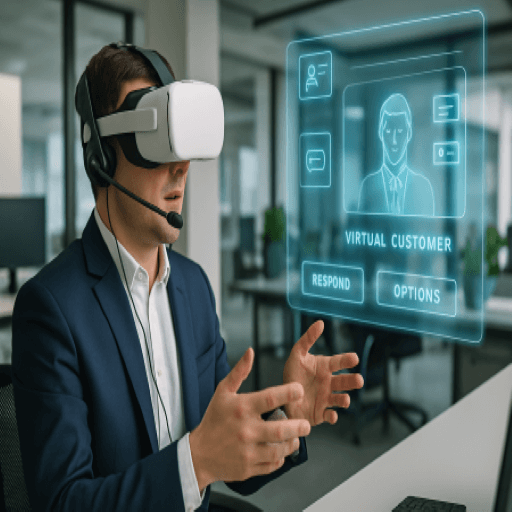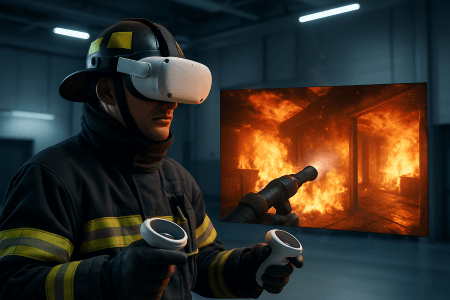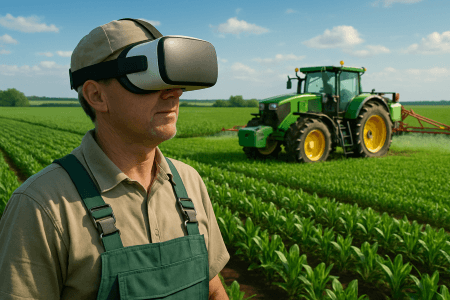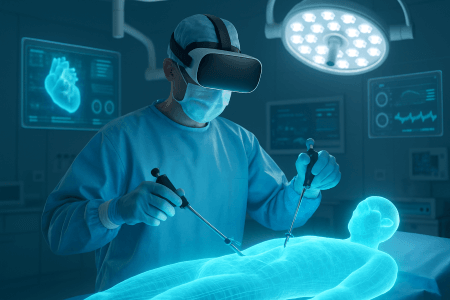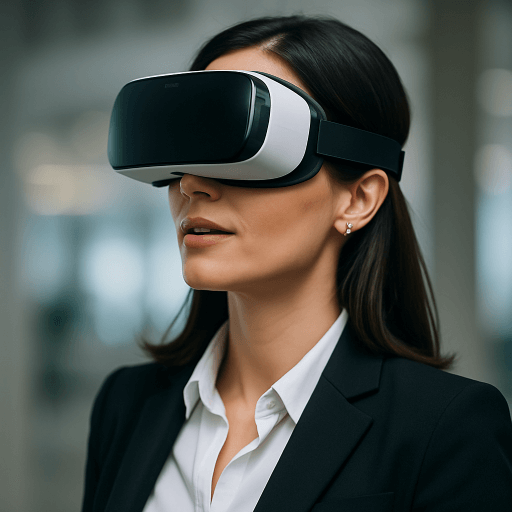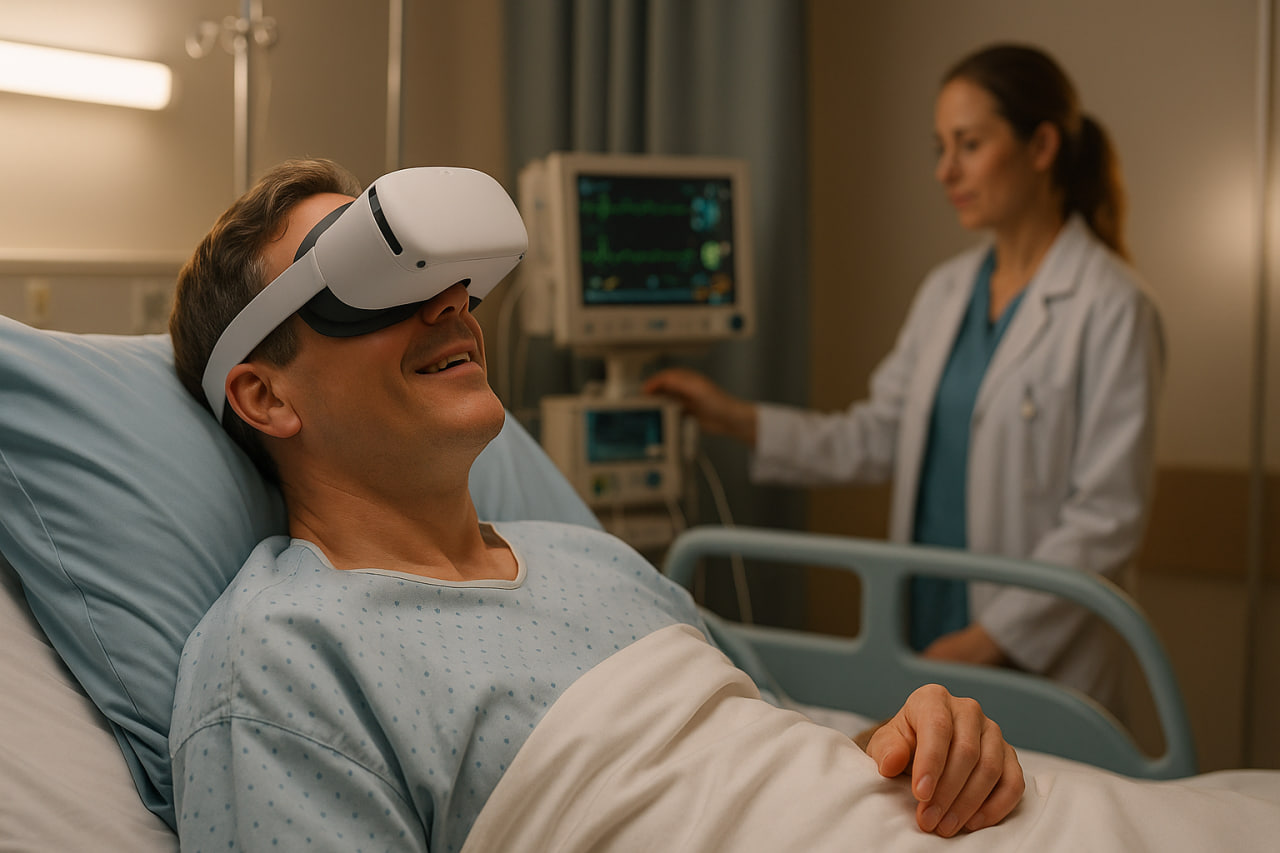VR Training: Future of Learning & Skill Development
Train for disaster without the disaster—thanks to VR. From the operating room to the firehouse, VR is changing how we learn to survive, all while cutting training costs dramatically.
In this post we’ll explore VR training, solving training problems, and giving you general examples of the fields where it’s being used and is usable.
This is just the beginning of the future of virtual reality.
Retention
Which teaches better: a book full of text, or a book full of pictures? Or, to ask it more precisely, why were illustrations added to books in the first place? Because visuals help us learn faster and remember better. What a single image can convey might take several pages of words to explain. The fact remains: we are visual learners at our core.
Now imagine illustrations that jump off the page—3D, interactive, multi-sensory, alive. Learning faster and remembering more? Research says yes. I’m talking about Virtual Reality.
The biggest problem with traditional learning, whether in schools or employee training, is retention. Kids go to school and push through months of learning, and everyone, including their parents, assumes they’ve learned everything. But that’s not true. The same goes for employees who go through training courses but later forget most of what they learned. They don’t retain the knowledge. And that’s the biggest flaw in traditional learning.
Studies have already shown that learning with VR has a much higher retention rate even after a long time, compared to reading textbooks or watching videos. The reason is simple: it’s immersive and feels like the real world. It gives you the sense that you’re actually doing what you’re learning. As the saying goes, “use it or lose it.” VR creates that opportunity through the headset and its interactive tools, allowing learners to engage and become far more prepared for real-world work.
The more immersive and game-like a VR experience, the better the retention. With a VR game development service, even complex skills can be learned through fun, interactive simulations.
Cost savings
Training employees is expensive, especially when they have to be there physically. The commute costs, the time spent traveling, it all adds up. VR learning is becoming more popular every day, and one major reason is that it solves exactly this problem. Employees don’t have to be physically present to learn new skills; they can simply put on a headset, grab the interactive tools, and start learning wherever they are.
By the way, if you’re wondering how you can get one of these magic experiences, I have to tell you that a Custom VR Development Service is exactly what you need.
Instant feedback
Recent studies show that making mistakes isn’t just okay, it’s absolutely necessary for deeper learning and long-term retention. Our minds rarely forget mistakes, which is exactly how we learn to avoid them. That’s the real purpose of exams: not to stress students out, but to help them identify weak spots and eliminate the illusion of knowing. We think we understand something, but until we can explain or apply it, we’re just familiar with it, not truly learning it.
So, what does VR have to do with this? VR gives instant feedback. Instead of rereading instructions endlessly and forgetting them later, learners can immediately see their mistakes and correct them on the spot. This matters a lot for companies, especially those using expensive machinery. A well-designed VR app can simulate every possible scenario, showing employees exactly what happens if they do X instead of Y. And because it feels so real, the lessons learned in VR stick far longer than anything read or watched.
Now that we understand the potential of VR, let’s take a look at a few examples of where it can be applied, or is already being used.
Aged Care Training
Did you know that taking care of elderly people can be even trickier than caring for children or infants? They are just as sensitive and emotional, and you need to know how to handle them, especially if your job or business revolves around caring for these precious souls. If you run such a business, staying up to date with new technologies and findings is essential. You simply can’t afford to lag behind.
Bringing in new employees is always a challenge, and this field is no exception. Training never stops, even when you hire highly educated staff, because technology and best practices are constantly evolving. And we can’t underestimate the fact that even well-trained employees might struggle with certain challenges or emotions. I only recently realized how emotionally demanding aged care can be. Many elderly people face complex mental and physical challenges, and not everyone has the ability to handle these situations effectively.
Fortunately, VR can help. It allows employees to practice handling all possible scenarios, improving their skills and tolerance for emotionally charged situations. By experiencing realistic simulations, staff can prepare for real-life challenges and be ready for anything that comes their way.
Firefighter training
One of the most dangerous jobs has always been firefighting. Not only do people’s lives depend on their expertise and intensity of training, but their own lives depend on their quick thinking, decision-making, and—most importantly—the ability not to panic.
When NASA selects astronauts for space missions, they aren’t just looking for the most skilled or smartest candidates. Skills and knowledge can be gained with practice. What really matters is staying cool-headed under pressure, the ability to handle extreme stress without panicking, because a multi-million-dollar mission can’t afford mistakes. Firefighters face the same challenge.
With VR simulations, firefighters can improve their training in practical ways—how to use hoses, move through dangerous environments, and perform critical tasks. But VR offers something more: it lets them experience the full stress of real situations in a safe, controlled environment. Each time they face a scenario, it feels intense but safe, helping them build confidence and training their mind not to panic. By the time they encounter a real-life fire, they’ve already mentally rehearsed the chaos countless times in VR, giving them a calm, confident edge when it matters most.
Indeed with the right Custom VR Development Service, training for high-risk jobs like firefighting will be revolutionized. At VRLex, our mission is to help train these brave, risk-taking individuals with the advanced preparation they deserve—not only to protect the lives of others but also to keep themselves safe when dangerous situations arise.
Rural Industries Skill Training
Agriculture has always been a tricky, important, and demanding field. It’s profitable, yes, but human lives depend on it, and like medicine or other critical areas, it deserves equal attention. Back in the Middle Ages, when agriculture started to expand, the lack of proper knowledge caused many costly problems. I won’t go into all the details, but the takeaway is clear: neglecting this field brings serious consequences.
Today, paying attention to agriculture is even more important than before—why? Climate change. Whether or not some people deny it, the evidence is all around us, and the catastrophic effects are undeniable. Agriculture is among the hardest hit sectors. Farmers now need more education than ever, not only to learn how to deal with these global challenges but also to protect human livelihoods.
Fortunately, some countries, like Australia, have started using VR to improve agricultural training. By the way, VRLex builds immersive VR experiences to help farmers learn with high retention.
Customer service
Ryan Holiday, the well-known American author, has a saying: “Unexpected failure is discouraging and being beaten back hurts.” By that, he means you shouldn’t be surprised when the unexpected happens. You shouldn’t get caught off guard, you should be prepared for every scenario and always have a backup plan.
Human beings rarely have backup plans for every field of life—business or personal. But there’s one area where the lack of preparation shows up the most: customer service.
Why? It is where you interact directly with people, and dealing with people is insanely difficult. Businesses, big or small, often face the bottleneck of finding employees who are genuinely kind, patient, and have the right attitude. Hiring the wrong person is costly and usually ends with lost customers.
Think about it: how many times have you gone somewhere, had a bad experience with the staff, and decided never to return? But the problem is even those rare “angel-souled” workers can lose their patience when faced with difficult, demanding customers.
So what’s the solution? Whether your staff is average, bad, or excellent, they need training: training for the unexpected, for handling difficult people who can make your entire business look bad by yelling, arguing, or demanding unreasonable things. A well-prepared team won’t just protect your business from losing customers; they’ll also protect each other from having their entire day ruined by one troublesome person.
Some businesses are already using VR to train their staff for dealing with angry customers, and let’s face it, these people really do exist. Proper training can prevent a lot of unexpected troubles in the future, giving you peace of mind knowing your staff can handle tough situations and navigate the storm.
This is exactly what Ryan Holiday meant by “anticipating the negative”—thinking ahead about all the bad things that might happen so you’re not caught off guard when they do.
Here at VRLex, we design VR apps for this very purpose. Our apps simulate all possible scenarios, with all kinds of customer interactions, inside a highly immersive and interactive virtual world—so your staff can get real experience before stepping into the real challenges.
Training Medical Surgeons with VR
If VR is going to revolutionize learning and training, one field stands out the most: medicine.
It’s a high-risk area. Medical students have always had to practice on real patients, and despite all the advances in technology, training methods haven’t really changed much in years. Patients, of course, often feel fear or frustration knowing that inexperienced students or new doctors are learning on them.
But now, with VR, that doesn’t have to be the case. Students can step into a virtual operating room and gain the experience of countless surgeries, going through the process step by step just as it would unfold in real life.
Because here’s the truth: a surgeon’s expertise isn’t just about IQ or how much medical knowledge they’ve memorized, it’s about experience. And VR finally makes it possible to get that experience safely, before ever touching a real patient.
electrical accidents
Electrical accidents happen everywhere, in almost every industry. There are many reasons for them, which we won’t get into here, but in this section, we’ll focus on how VR can help reduce these accidents. Often, the causes are related to training gaps or retention problems—exactly the areas where VR can make a huge difference. It’s not an exaggeration to say this technology is already being used by Intel. VR saves lives, prevents costly machinery breakdowns, and is 100% a smart investment.
Happy reading! If you have any questions, feel free to drop me a message on WhatsApp!
-
How does VR improve learning retention compared to traditional methods?
Humans learn better with visuals, and VR adds interactive, multi-sensory elements. This immersive experience significantly increases retention.
-
How does VR training save costs for companies?
VR eliminates the need for physical attendance, cutting travel, setup, and instructor expenses—saving both time and money.
-
What industries can benefit from VR training?
Almost every industry. VR can be applied to any niche, from healthcare to customer service to high-risk jobs.
-
Is VR training expensive to implement?
Initial costs exist, but it pays off by preventing more expensive mistakes and inefficiencies in the long run.
-
How realistic are VR simulations?
Highly realistic. With multi-sensory, carefully crafted visuals, VR can replicate scenarios—like a firefighter facing a real fire—making the experience feel authentic and preparing trainees effectively.
